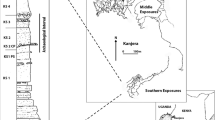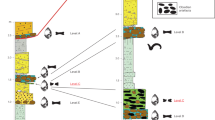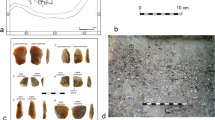Abstract
Archaeologists generally argue that early (ca. 11,000–8000 B.P. populations on the North American Great Plains moved over very large areas, relying on sophisticated, biface-based flaked stone technology and on extensive resharpening and recycling of tools to cope with unpredictable access to raw material sources. This paper reviews the development of this reconstruction and considers the degree to which data from assemblages of Paleoindian flaked stone tools support it. Published information implies that patterns of raw material use vary greatly over the Plains, that bifaces were not the centerpiece of Paleoindian technology, that there are no published efforts to document an unusual degree of resharpening or recycling, and that the data that are available on these topics do not suggest that either was important. Detailed analysis of one assemblage, from the Allen site in southwestern Nebraska, carried out with these issues in mind, shows similar patterns. The great difference between what the literature says about Paleoindian technology and the documented character of that technology suggests that Paleoindian lifeways were far more variable than current discussions suggest.
Similar content being viewed by others
REFERENCES
Akoshima, K., and Frison, G. (1996). Lithic microwear studies of the Mill Iron site tools. In Frison, G. (ed.), The Mill Iron Site, University of New Mexico Press, Albuquerque, pp. 71–86.
Amick, D. (1995). Patterns of technological variation among Folsom and Midland projectile points in the American Southwest. Plains Anthropologist 40: 23–38.
Anderson, D. (1980). The stone tool assemblage from the Cherokee Sewer Site. In Anderson, D. (ed.), The Cherokee Excavations, Academic Press, New York, pp. 197–238.
Bamforth,D. B. (1985). The technological organization of Paleoindian small-group bison hunting on the Llano Estacado. Plains Anthropologist 30: 243–258.
Bamforth, D. (1988). Ecology and Human Organization on the Great Plains, Plenum, New York.
Bamforth, D. B. (1991a). Flintknapping skill, communal hunting, and Paleoindian projectile point typology. Plains Anthropologist 36: 309–322.
Bamforth, D.B. (1991b).Technological organization and hunter/gatherer mobility:ACalifornia example. American Antiquity 56: 216–234.
Bamforth, D. B. (1998). Test excavations at 5GA872, theWindy Ridge quartzite quarry, Report Submitted to the USDA Forest Service, Routt National Forest, Steamboat Springs, CO.
Bamforth, D. B. (1999a). The Paleoindian occupation of the Medicine Creek drainage, southwestern Nebraska. In Roper, D. (ed.), Seventy Years of Archaeology at Medicine Creek, University of Alabama Press, Tuscaloosa. In press.
Bamforth, D. B. (1999b). Rethinking the role of bifaces in Paleoindian technology on the Great Plains. In Dibble, H., and Soressi, M. (eds.), From Coups de Poing to Clovis: New Perspectives on BifacialTechnology, University of Pennsylvania Press, Philadelpia. In press.
Bamforth, D. B., and Becker, M. (1999). A microwear analysis of selected artifacts from the Hell Gap site, Report Submitted to the Anthropology Department, University of Wyoming.
Bamforth, D. B., and Becker, M. (2000). Core/biface ratios, mobility, refitting, and artifact use-lives: A Paleoindian example. Plains Anthropologist 45: 273–290.
Bement, L. (1999). The Cooper Site, University of Oklahoma Press, Norman, OK.
Binford, L. R. (1977).Forty-seven trips. In Wright, R.V. S. (ed.), StoneTools as Cultural Markers, Australian Institute of Aboriginal Studies, Canberra, pp. 24–36.
Blackmar, J. (2001). Regional variability in Clovis, Folsom, and Cody land use. Plains Anthropologist 46: 65–94.
Boldurian, A. (1990). Lithic technology at the Mitchell Locality of Blackwater Draw. Plains Anthropologist Memoir 24.
Boldurian, A. (1991). Folsom mobility and organization of technology:Aview from Blackwater Draw, New Mexico. Plains Anthropologist 36: 281–296.
Boldurian, A., and Cotter, J. (1999). Clovis Revisited: New Perspectives on Paleoindian Adaptations From Blackwater Draw, New Mexico, University Museum Monograph No. 103, University Museum, University of Pennsylvania, Philadelphia, PA.
Boldurian, A., and Hubinsky, S. (1994). Preforms in Folsom lithic technology. Plains Anthropologist 39: 445–464.
Bordes, F. (1961). Typologie du Paléolithique ancien et moyen. Publication de l'Institut de L'Université de Bordeaux, Mémoire 1, Bordeaux.
Bradley, B. (1982). Flaked stone technology and typology. In Frison, G., and Stanford, D. (eds.), The Agate Basin Site, Academic Press, New York, pp. 181–208.
Bradley, B. (1991). Lithic technology. In Frison, G. (ed.), Prehistoric Hunters of the High Plains, Academic Press, New York, pp. 369–396.
Bradley, B., and Frison, G. (1987). Projectile points and specialized bifaces from the Horner Site. In Frison, G., and Todd, L. (eds.), The Horner Site, Academic Press, New York, pp. 199–232.
Bradley, B., and Frison, G. (1996). Flaked-stone and worked-bone artifacts from the Mill Iron site. In Frison, G. (ed.), The Mill Iron Site, University of New Mexico Press, Albuquerque, pp. 43–70.
Callahan, E. (1979). The basics of biface manufacture in the Eastern Fluted Point Tradition. Archaeology of Eastern North America 7: 1–180.
Close, A. E. (1991a). On the validity of Middle Paleolithic tool types: A test case from the eastern Sahara. Journal of Field Archaeology 18: 256–264.
Close, A. E. (1991b). Reply to Dibble. Journal of Field Archaeology 18: 267–269.
Collins, M. (1999). Clovis Blade Technology, University of Texas Press, Austin.
Davis, E. M. (1954). Culture History of the Central Great Plains Prior to the Introduction of Pottery, PhD Dissertation, Anthropology Department, Harvard University.
Davis, E. M. (1962). Archaeology of the Lime Creek site in southwestern Nebraska, Special Publication of the Nebraska State Museum, Vol. 3.
Debénath, A., and Dibble, H. (1994). Handbook of Paleolithic Typology, Vol. 1: Lower and Middle Paleolithic of Europe, University of Pennsylvania, Philadelphia, PA.
Dibble, H. (1984). The interpretation of Middle Paleolithic scraper morphology. American Antiquity 52: 109–117.
Dibble, H. (1991). Rebuttal to Close. Journal of Field Archaeology 18: 264–267.
Dibble, H. (1995). Middle Paleolithic scraper reduction: Background, clarification, and review of evidence to date. Journal of Archaeological Method and Theory 2: 299–368.
Duncan, M. (1995). Calf Creek foragers: Mobility in the Southern Plains during the Altithermal. Bulletin of the Oklahoma Archaeological Society 42: 89–144.
Flenniken, J. (1978). Reevaluation of the Lindenmeier Folsom: A replication experiment in lithic technology. American Antiquity 43: 473–480.
Francis, J., and Larson, M. (1996). Chipped stone raw material from the Mill Iron site. In Frison, G. (ed.), The Mill Iron Site, University of New Mexico Press, Albuquerque, pp. 87–100.
Frison, G. (1974). The Casper Site, Academic Press, New York.
Frison,G. (1982a). Paleoindian winter subsistence strategies on the High Plains. In Ubelaker, D., and Viola, H. (eds.), Plains Indian Studies (Smithsonian Contributions in Anthropology, vol. 30), Smithsonian Institution Press, Washington, DC, pp. 193–201.
Frison, G. (1982b). The Folsom components. In Frison, G., and Stanford, D. (eds.), The Agate Basin Site, Academic Press, New York, pp. 37–75.
Frison, G. (1984). The Carter/Kerr-McGee Paleoindian site: Cultural resource management and archaeological research. American Antiquity 49: 288–314.
Frison, G. (1996). The Mill Iron Site, University of New Mexico Press, Albuquerque.
Frison, G., and Bradley, B. (1980). Folsom Tools and Technology at the Hanson Site, Academic Press, New York.
Frison, G., and Bradley, B. (1999). The Fenn Cache, One Horse Land and Cattle Company, Santa Fe, New Mexico.
Frison, G., and Stanford, D. (1982). The Agate Basin Site, Academic Press, New York.
Frison, G., and Todd, L. (1987). The Horner Site, Academic Press, New York.
Goodyear, A. (1989). A hypothesis for the use of cryptocrystalline raw materials among Paleoindian groups of North America. In Ellis, C., and Lothrop, J. (eds.), Eastern Paleoindian Lithic Resource Use, Westview Press, Boulder, CO, pp. 1–9.
Gould, R. (1978). Beyond analogy in ethnoarchaeology. In Gould, R. (ed.), Explorations in Ethnoarchaeology, University of New Mexico Press, Albuquerque, pp. 249–293.
Gramly, R. (1980). Raw material source areas and “curated” tools. American Antiquity 45: 823–833.
Gramly, R. (1982). The Vail site. Bulletin of the Buffalo Society of Natural Sciences 30.
Gramly, R. (1993). The Richey Clovis Cache, Persimmon Press Monographs in Archaeology, Buffalo.
Harrison, B., and Smith, H. (1975). A test excavation of the Lake Theo site, Briscoe County, Texas. Panhandle-Plains Historical Review 48: 70–108.
Hartwell, W. (1995). The Ryan's site cache: Comparisons to Plainview. Plains Anthropologist 40: 165–184.
Hayden, B. (1982). Interaction parameters and the demise of Paleo-Indian craftmanship. Plains Anthropologist 27: 109–123.
Hemmings,E. T. (1987). The Homer site debitage. In Frison, G., and Todd, L. (eds.), The Horner Site, Academic Press, New York, pp. 435–442.
Hester, J. (1962). A Folsom lithic complex from the Elida site, Roosevelt County, N.M. El Palacio 12: 92–113.
Hester, J. (1972). Blackwater Locality No. 1,Fort Burgwin Research Center, Southern Methodist University.
Hill, M. (2001). Paleoindian Diet and Subsistence Behavior on the Northwestern Great Plains of North America, PhD Dissertation, Anthropology Department, University of Wisconsin, Madison.
Hofman, J. (1991). Folsom land use: Projectile point variability as a key to mobility. In White, A., and Holen, S. (eds.), Raw Material Economies Among Prehistoric Hunter–Gatherers (University of Kansas Publications in Anthropology, Vol. 19), pp. 335–356. University of Kansas, Lawrence, Kansas.
Hofman, J. (1992). Recognition and interpretation of Folsom technological variability on the Southern Plains. In Stanford, D., and Day, J. (eds.), Ice Age Hunters of the Rockies, Denver Museum of Natural History, Denver, pp. 193–224.
Hofman, J., Amick, D., and Rose, R. (1990). Shifting sands: A Folsom–Midland assemblage from a campsite in western Texas. Plains Anthropologist 35: 221–254.
Hofman, J., Todd, L., and Collins, M. (1991). Identification of central Texas Edwards chert at the Folsom and Lindenmeier sites. Plains Anthropologist 36: 297–308.
Holder, P., and Wike, J. (1949). The Frontier Culture Complex, a preliminary report on a prehistoric hunter's camp in southwestern Nebraska. American Antiquity 14: 260–266.
Holen, S. (1991). Bison hunting terrirories and lithic acquisition among the Pawnee: An ethohistoric and archaeological study. In Montet-Whte, A., and Holen, S. (eds.), Raw Material Economies Among Prehistoric Hunter–Gatherers (University of Kansas Publications in Anthropology, Vol. 19), pp. 399–411. University of Kansas, Lawrence, Kansas.
Holliday, V. (1997). Paleoindian Geoarchaeology of the Southern High Plains, University of Texas Press, Austin.
Holliday, V. (2000). The evolution of Paleoindian geochronology and typology on the Great Plains. Geoarchaeology 15: 227–290.
Holliday, V., and Welty, C. (1981). Lithic tool resources on the Llano Estacado. Bulletin of the Texas Archaeological Society 52: 227–250.
Hughes, J., and Willey, P. (1978). Archaeology at Mackenzie Reservoir, Archaeological Survey Report No. 24, Texas Historical Commission, Office of the State Archaeologist.
Ingbar, E. (1992). The Hanson site and Folsom on the Northwestern Plains. In Stanford, D., and Day, J. (eds.), Ice Age Hunters of the Rockies, Denver Museum of Natural History, Denver, pp. 169–192.
Ingbar, E. (1994). Lithic raw material selection and technological organization. In Carr, P. (ed.), The Organization of North American Prehistoric Chipped Stone Technologies, International Monographs in Prehistory, Archaeological Series 7, Ann Arbor, Michigan, pp. 9–34, University of Michigan.
Ingbar, E., and Larson, M. L. (1996). Spatial analysis of the Northwestern Block excavation. In Frison, G. (ed.), The Mill Iron Site, University of New Mexico Press, Albuquerque, pp. 15–24.
Irwin-Williams, C., Irwin, H., Agogino, G., and Haynes, V. (1973). Hell Gap: Paleoindian occupation on the High Plains. Plains Anthropologist 18: 40–53.
Johnson, E. (1987). Lubbock Lake, Texas A and M University Press, College Station, TX.
Keeley, L. (1980). Experimental Determination of Stone Tool Uses, University of Chicago Press, Chicago.
Kehoe, T. (1973). The Gull Lake Site, Publications in Anthropology and History, Vol. 1, Milwaukee Public Museum, Milwaukee.
Kelly, R., and Todd, L. (1988). Coming into the country: Early Paleoindian hunting and mobility. American Antiquity 53: 231–244.
Knell, E. (1999). Late Paleoindian Cody Period Mobility Patterns: An Example From the Locality V Cody Component at the Hell Gap Site, Wyoming, Master's Thesis, Department of Anthropology, University of Wyoming.
Knudson, R. (1983). Organizational variability in Late Paleoindian assemblages. Reports of Investigations, Vol. 60. Laboratory of Anthropology, Washington State University, Pullman.
Kreutzer, L. (1996). Taphonomy of the Mill Iron site bison bonebed. In Frison, G. (ed.), The Mill Iron Site, University of New Mexico Press, Albuquerque, pp. 101–144.
Kuhn, S. (1992). Blank form and reduction as determinants of Mousterian scraper morphology. American Antiquity 57: 115–128.
LeTourneau, P. (2000). Folsom Toolstone Procurement in the Southwest and Southern Plains, PhD Dissertation, Anthropology Department, University of New Mexico.
Lothrop, J. (1989). The organization of Paleoindian lithic technology at the Potts site. In Ellis, C., and Lothrop, J. (eds.), Eastern Paleoindian Lithic Resource Use,Westview Press, Boulder, CO, pp. 99–137.
MacDonald, G. (1968). Debert: A Paleo-Indian Site in Central Nova Scotia, Persimmon Press, Buffalo.
MacDonald, D. (1999). Modelling Folsom mobility, technological organization, and mating strategies in the Northern Plains. Plains Anthropologist 44: 143–164.
May, D. (in press). Stratigraphic studies at Paleoindian sites around medicine Creek Reservoir. In Roper, D. (ed.), SeventyYears of Archaeology at Medicine Creek, University of Alabama Press, Tuscaloosa.
McBrearty, S., Bishop, L., Plummer, T., Dewar, R., and Conard, N. (1998). Tools underfoot: Human trampling as an agent of lithic artifact edge modification. American Antiquity 63: 108–131.
McCartney, P. (1991). Alternative hunting strategies in Plains Paleoindian adaptations. In Davis, L., and Reeves, B. (eds.), Hunters of the Recent Past, Unwin Hyman, Boston, pp. 111–121.
Meltzer, D. (1988). Late Pleistocene human adaptations in eastern North America. Journal of World Prehistory 2: 1–53.
Meltzer, D. (1989). Was stone exchanged among eastern North American Paleoindians? In Ellis, C., and Lothrop, J. (eds.), Eastern Paleoindian Lithic Resource Use, Westview Press, Boulder, CO, pp. 11–39.
Nelson, M. (1990). The study of technological organization. Archaeological Method and Theory 3: 57–100.
Reher, C., and Frison, G. (1980). The Vore site, 48CK302. Plains Anthropologist Memoir 16.
Reider, R. (1996). Soils and geomorphic surfaces of the Mill Iron site. In Frison, G. (ed.), The Mill Iron Site, University of New Mexico Press, Albuquerque, pp. 195–204.
Root, M. (2000). The Archaeology of the BobtailWolf Site.Washington State University Press, Pullman, WA.
Root, M., William, J.D., and Emerson, A. (2000). Stone tools and flake debris. In Root, M. (ed.), The Archaeology of the BobtailWolf Site, Washington State University Press, Pullman,WA, pp. 223–308.
Sellet, F. (1999). A Dynamic View of Paleoindian Assemblages at the Hell Gap Site, Wyoming: Reconstructing Technological Systems, PhD Dissertation, Department of Anthropology, Southern Methodist University, Dallas.
Splawn, B. (1995). A complete Calf Creek biface from the Arkansas River, Kay County, Oklahoma. Bulletin of the Oklahoma Archaeological Society 62: 37–40.
Stanford, D. (1978). The Jones-Miller site. Plains Anthropologist Memoir 14: 90–97.
Tankersley, K. (1998). Variation in Early Paleoindian economies of Late Pleistocene eastern North America. American Antiquity 63: 7–20.
Thurmond, J. P. (1990). Late Paleoindian utilization of the Dempsey Divide on the Southern Plains. Plains Anthropologist Memoir 25.
Todd, L. (1987). Taphonomy of the Horner II bonebed. In Frison, G., and Todd, L. (eds.), The Horner Site, Academic Press, New York, pp. 107–198.
Todd, L., Hofman, J., and Schultz, C. (1990). Seasonality of the Scottsbluff and Lipscomb bison bonebeds: Implications for modeling Paleoindian subsistence. American Antiquity 55: 813–827.
Tunnell, C. (1977). Fluted point production as revealed by lithic specimens from the Adair-Steadman site in northwest Texas. In Johnson, E. (ed.), Paleoindian Lifeways,West Texas Museum Association, Lubbock, pp. 140–168. The Museum Journal.
Wedel, W. (1986). Central Plains Prehistory, University of Nebraska Press, Lincoln.
Weissner, P. (1982). Risk, reciprocity, and social influences on !Kung San economics. In Leacock, E., and Lee, R. (eds.), Politics and History in Band Societies, Cambridge University Press, Cambridge, pp. 61–84.
Wheat, J.B. (1972).The Olsen-Chubbuck site. Memoirs of the Society for American Archaeology 26.
Wheat, J. B. (1979). The Jurgens site. Plains Anthropologist Memoir 15.
Wheeler, R. (1995). Archaeological Investigations in Three Reservoir Areas in South Dakota and Wyoming, Part 1: Angostura Reservoir. Reprints in Anthropology, Vol. 46, J and L Reprint Company, Lincoln, Nebraska.
William, J.D. (2000). Folsom stone tools. In William, J.D. (ed.), The Big Black Site (32DU955C), Washington State University Press, Pullman, WA, pp. 169–230.
Wilmsen, E. (1974). Lindenmeier: A Pleistocene Hunting Society, Harper & Row, New York.
Wilmsen, E., and Roberts, F. (1984). Lindenmeier, 1934–1974: Concluding report on investigations. Smithsonian Contributions to Anthropology, Vol. 24.
Witthoft, J. (1952). A Paleoindian site in eastern Pennsylvania, an early hunting culture. Proceedings of the American Philosophical Society 96: 464–495.
Wyckoff, D. (1964). The cultural sequence at the Packard site, Mayes County, Oklahoma, Oklahoma River Basin Survey, Archaeological Site Report No. 2.
Wyckoff, D. (1996). The Westfahl and Engle bifaces: Isolated finds of large bifaces on the Southern Plains. Plains Anthropologist 41: 287–296.
Wyckoff, D., and Taylor, L. (1971). The Pumpkin Creek Site: An Early Archaic site in the Southern Plains border. Plains Anthropologist 16: 20–50.
Yellen, J. (1977). Archaeological Approaches to the Present, Academic Press, New York.
Author information
Authors and Affiliations
Rights and permissions
About this article
Cite this article
Bamforth, D.B. High-Tech Foragers? Folsom and Later Paleoindian Technology on the Great Plains. Journal of World Prehistory 16, 55–98 (2002). https://doi.org/10.1023/A:1014567313865
Issue Date:
DOI: https://doi.org/10.1023/A:1014567313865




